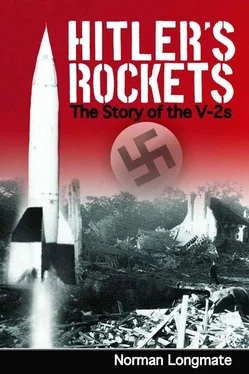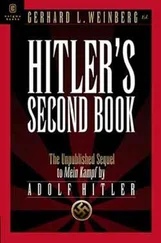Nothing appeared. The projectile flew on imperturbably…. At that moment on 3 October 1942 supersonic speed was achieved for the first time by a liquid-propellant rocket…. The reddish flame had vanished. The thick white vapour trail was forming no longer. Only a thin, milky streak of mist still followed the rocket as it raced away at a speed of over 3000 m.p.h.
For the rocket men this, far more than the later first operational firing of the A-4, was the real moment of triumph. Even the normally detached scientists and army officers who had achieved it were caught up in the excitement of the moment, not least Dornberger himself:
I couldn’t speak for a moment; my emotion was too great. I could see that Colonel Zanssen was in the same state. He was standing there laughing. His eyes were moist. He stretched out his hands to me. I grasped them. Then our emotions ran away with us. We yelled and embraced each other like excited boys…. Everyone was shouting, laughing, leaping, dancing and shaking hands…. As I went out into the street half the technical staff came dashing towards me. There was a great deal of handshaking. I bundled von Braun into the car and we drove to Test Stand VII. As we shot through the open gate in the sand-built walls surrounding the great arena we beheld something like a popular riot. The test field crews had surrounded Dr Thiel and their chief engineers…. I can still see Thiel’s face, with his shrewd savant’s eyes sparkling behind his thick spectacles…. His response to my congratulations was a flood of new ideas and suggestions for improvement.
The actual splashdown, marked by sudden silence from the radio which had been transmitting a continuous note ever since lift-off, came as almost an anticlimax to the shouting, laughing crowd of scientists assembled round the loudspeakers. Young Dr Steinhoff, whom Dornberger had found wandering around the test area several years earlier, was sent off in a Messerschmitt to locate the precise spot, marked by brightly coloured dye in the sea, and returned with more good news: the missile had travelled 120 miles and come down only two and a half miles wide of its aiming-point. Already Dornberger had fulfilled one private ambition. ‘Our rocket today’, he told his excited audience at a celebratory party that evening, ‘reached a height of nearly 60 miles. We have thus broken the world height record of 25 miles previously held by the ... Paris gun.’ To Dornberger, the artillery-man and First World War veteran, this no doubt meant more than it did to the scientists around him, and just in case the day’s success should set their minds moving again in the direction of that old dream, space travel, he added a stern reminder of their real purpose:
The development of possibilities we cannot yet envisage will be a peacetime task…. So long as the war lasts, our most urgent task can only be the rapid perfection of the rocket as a weapon.
It looks as though we’ll have to take these rockets seriously.
British Air Intelligence Officer, 27 March 1943
When the war began, the British government had no suspicion that the Germans might be developing long-range rockets, and the possibility was examined seriously only because of a mistake. Hitler’s speech at Danzig on 19 September 1939 boasting that the Nazis might ‘use a weapon which is not yet known and with which we ourselves cannot be attacked’ led to a young government scientist, Dr R. V. Jones, being instructed to search the files of the Secret Intelligence Service for clues as to the identity of ‘Hitler’s secret weapon’. His report, ‘The Hitler Waffe ’, running to six foolscap pages, submitted on 11 November 1939, identified seven ‘weapons to which several references occur, of which some must be considered seriously’, the fifth of these being ‘long-range guns and rockets’, although he concluded that in all probability ‘Hitler’s weapon was neither bluff nor novelty, but merely the extensive use of his air force’. This interpretation is now generally accepted as being correct, but ‘The Hitler Waffe’ remains important, since it marks the first systematic study of the rocket threat.
The secret-weapon investigation helped to make Dr Jones’s unique role, which he regarded as essentially that of keeping an eye open for significant developments in German weapons, especially in the air, well known throughout Whitehall, and his name was constantly to recur whenever such matters were discussed during the next few years. Still only twenty-eight, he had taken a first in physics at Oxford, where he had worked in the Clarendon Laboratory under the famous Professor Frederick Lindemann, known as ‘Prof’ to his students and to his close friend, Winston Churchill. It was thanks to Lindemann that R. V. Jones first became involved in government research, while still doing postgraduate work at Oxford, though the £50 he received for equipment was somewhat less than the millions of marks the Germans were at that time spending on Peenemünde. He had entered the scientific civil service in 1936 with the salary, unprecedented for someone of his age, of £500 a year, and shortly after the outbreak of war had transferred to Air Intelligence Branch AI (I (c)), which was closely linked to MI6, known more commonly as SIS, the Secret Intelligence Service. In this capacity, while working at SIS headquarters at 54 Broadway in Victoria, he had constant contacts with ‘Station X’, at Bletchley Park in Buckinghamshire, which housed the SIS pre-war files and was to become well known as the centre of intelligence obtained from breaking German codes, including the Ultra material enciphered on the Enigma machine. Dr Jones also became personally acquainted with almost everyone else of importance in the intelligence war, including the ‘Y’ Section, responsible for intercepting ordinary German signals traffic, and the staff, military and civilian, of the Royal Aircraft Establishment at Farnborough, Britain’s nearest equivalent to Peenemünde. All these links were to prove of crucial importance, and before long Dr Jones had acquired a well-qualified colleague, Squadron Leader S. D. Felkin, later famous for his skill in interrogating German prisoners. The British intelligence system lacked neither resources nor professional talent. Where it was sadly deficient was in scientific knowledge. ‘The average SIS agent’, Dr Jones wrote later, ‘was a scientific analphabet’ – i.e. he lacked even the ABC of that area of knowledge.
While still completing his secret-weapon study, Dr Jones found another problem literally dumped on his desk, the sevenpage document known as the ‘Oslo Report’, left a week earlier at the British Legation in Norway, apparently by a German well-wisher to the Allied cause. Dr Jones took it seriously from the first, recognizing that it ‘was obviously written by someone with a good scientific and technical background’, dismissing the suspicions of some of his colleagues that it might be a German ‘plant’. The Oslo Report mentioned, for the first time in any intelligence source, a research establishment at Peenemünde, and the development by the German army of rocket projectiles 80 cm (32 in) wide.
In May 1940 British military intelligence received information that a scientist called Oberth was collaborating with the Germans on producing a 30 ton rocket with a range of 160 miles at an establishment near Stettin. Most unfortunately it did not reach the Air Ministry, where Dr Jones at least would have recognized the name of Professor Oberth as the ‘father’ of German rocket research and an expert on liquid-fuelled rockets and could have identified the ‘establishment near Stettin’ as Peenemünde. Here the consequences of the intelligence service’s lack of scientifically trained officers were strikingly demonstrated.
Читать дальше






![Traudl Junge - Hitler's Last Secretary - A Firsthand Account of Life with Hitler [aka Until the Final Hour]](/books/416681/traudl-junge-hitler-s-last-secretary-a-firsthand-thumb.webp)





